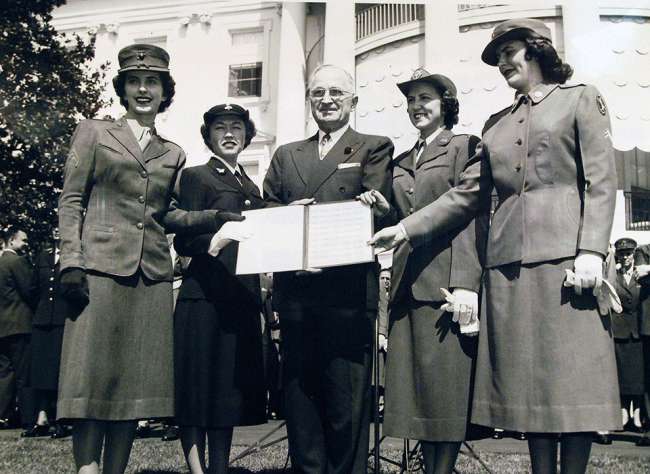Top Image: Soviet soldiers taking down a Nazi sign in Austria. Image courtesy of Voennyi Albom (a Russian-language website) and Sputnik News.
Nazi Germany annexed Austria in 1938, with the overwhelming support of the Austrian population. Even figures such as Karl Renner, an Austrian socialist politician who was the provisional prime minister of the first post-Nazi government appointed by Joseph Stalin, welcomed the Anschluss. Thereafter, Austria was an integral part of the Third Reich, with 700,000 people, or 10 percent of the population, joining the Nazi Party. The Wehrmacht drafted more than 1.3 million Austrians between 1938 and 1945, 242,000 of whom never came back home. Austrians also served loyally as soldiers from Germany proper and were just as responsible for Nazi atrocities on the Eastern Front.
The story of the Red Army’s occupation of Austria begins in June 1941, when Hitler’s regime launched a genocidal war against the Soviet Union. The aim of Operation Barbarossa was not only to eliminate the Soviet Union as a potential military threat but also to starve and enslave the European population of the country and turn it into a German colony. The Soviet Union lost 26.6 million people during the war, with most credible estimates for military losses ranging between 11.4 and 14.6 million.
After almost four years of brutal combat, the troops from the 3rd and 2nd Ukrainian Fronts, the two army groups at the southern end of the Soviet-German frontline, approached Austria’s border from Hungary in the winter of 1945. The fighting in Hungary was some of the most brutal of the war, as the two Red Army groups, numbering around 1 million troops at the time, suffered 484,300 losses, including 140,000 killed or captured. As they were regrouping to invade Austria, the Germans launched their last major offensive of the war at Lake Balaton in March of 1945, which was aimed at stopping the Soviet march into the Third Reich. After the 3rd Ukrainian Front absorbed the attack, it launched a counterattack that developed into the Vienna Strategic Offensive Operation, resulting in the elimination of the bulk of German forces in the south and the capture of the Austrian capital. After the Soviet troops took Vienna, they advanced towards Linz and Graz in early May. Skirmishes between the Red Army and the German soldiers, who desperately sought to surrender to the Western Allies and avoid falling into Soviet captivity, lasted into late May, well after the fighting ceased elsewhere in Europe. The Red Army suffered 94,185 casualties in Austria, 26,006 killed and 68,179 wounded.
Soviet occupation policies in Austria were to a large extent shaped by the Moscow Declaration of 1943, in which the British, Americans, and Soviets proclaimed that Austria was Germany’s first victim, but that it would also have to pay the price for its participation in Nazi aggression. In the long run, the Declaration meant that Austria would emerge as an independent state. The Red Army occupied only parts of Austria, including the capital, while the Anglo-American troops entered from Germany and Italy. Thereafter, France, Great Britain, the United States, and the Soviet Union divided Austria into four occupation zones, much like they did in Germany.
Although Moscow treated Austria as a defeated Axis power, it adhered to the general line that Austria was a victim of Germany. Therefore, Austria avoided some of the worst aspects of Germany’s fate. It did not lose any territory, despite Yugoslavia’s claims to Carinthia, a province in the south of the country. Austrians also avoided the fate of the Volksdeutsche, ethnic Germans from Eastern Europe who were expelled to Germany or rounded up and deported to the Soviet Union for slave labor. Likewise, Austrians did not become victims of ethnic cleansing, like Germans from the Third Reich’s territories incorporated into Poland and the Soviet Union. The Western Allies also successfully opposed the Kremlin’s plans to impose burdensome war reparations on Austria that Germany, Romania, and Hungary had to pay.
However, the Western Allies consented to Moscow’s demand that the Soviets should be entitled to German assets in Austria in their zone of occupation. Moscow considered German property to be all property that at the end of the war had German owners or investors. As a result, according to historian Günter Bischof, Austria ended up paying more than five times what Stalin originally demanded. In Austria, as in other “enemy” countries, local governments were obliged to feed and clothe the Red Army, which, given the number of troops, was an enormous burden on the war-ravaged countries.
Moscow deployed NKVD (Soviet secret police) teams of professional looters to extract reparations through requisitions: the NKVD teams seized industrial plants and production installations while confiscating goods in the quantity of 31,200 freight cars. In June 1946, 30 percent of the national budget went into covering the occupation costs. Historian Walter Iber estimated that in total Austria paid the Soviet Union 36.8 billion Schillings, or two percent of the accumulated GDP, from 1946 to 1955.
The fact that Moscow did not plan or try to impose a communist dictatorship in Austria meant that the scale of political violence experienced by Austrians was more limited than in other countries occupied by the Red Army. According to the research of Harold Knoll and Barbara Stelzl-Marx, in 1945, or the initial eight months of occupation, Soviet military tribunals arrested around 800 Austrian civilians. For 400 of them, the charges are known: 191 were charged with belonging to the Nazi Werewolf resistance group, 61 with espionage, 55 of maltreatment of Soviet POWs and slave laborers, 31 of weapons possession, 22 of war crimes, 24 with violent acts, 11 for selling bad alcohol to Soviet troops, four with criminal activities, and one for being a former Soviet citizen. By 1955, when the Red Army pulled out of the country, the Soviets had arrested 2,400 Austrians, 1,250 of whom were prosecuted for everything from war crimes to everyday criminal activity. Some 150 were executed, while others received lengthy prison terms.
By the standards of the Soviet justice system, and given the significant Austrian contribution to Nazi war crimes, the Soviet repressive apparatus in the first months of occupation acted with considerable restraint. This restraint can be partly explained by the fact that Moscow did not fully control Austria and partly because Austria was far from the Soviet Union’s frontiers. Consequently, it did not rank high on Moscow’s list of geopolitical priorities. It was far more important for the Kremlin to have a friendly and preferably communist regime in a neighboring country, such as Romania or Poland, whose adjoining territory made it a potential military threat to the Soviet Union. In these countries, the Soviet terror was worse.
Throughout the war, the Soviet leadership sustained the army’s morale through vicious anti-German hate propaganda, which given the Axis genocidal conduct in the Soviet Union, resonated powerfully with the rank and file. The anti-German indoctrination campaign fueled atrocities against civilians. As they closed in on the Third Reich, the Soviet soldiers committed hundreds of thousands of sexual assaults, robberies, and murders. By April 1945, with the fall of the Third Reich imminent, the Soviet leaders began thinking about the post-war period where they would have to govern the newly conquered territories, and thus require at least some support from the defeated Germans.
Suddenly, the tone and message of Soviet propaganda abruptly changed. The hate campaign did not completely go away, but the most vehement anti-German propagandists, such as the widely popular military journalist Il’ia Ehrenburg, were criticized in the Soviet civilian and military press for “going too far.” Soviet propaganda also began to emphasize that the ordinary Germans (and Austrians) were not responsible for the Nazi crimes.The change in propaganda tone was aimed at differentiating ordinary Germans from the Nazis, to encourage Soviet soldiers to treat civilians more correctly.
Soviet commanders in the field issued orders to troops to discourage criminal conduct as soon they entered Austria. On April 4, the command issued an instruction that was read to all of the frontline soldiers. The instruction proclaimed that Austria was Hitler’s first victim and that the Red Army entered the country to liberate it and destroy German forces. It stated that Nazi propaganda for years had frightened the Austrians with tales of the Soviet soldiers committing atrocities. Calling Nazi propaganda a lie, the instruction went on to appeal to troops not to conflate Austrian civilians with German occupiers. The document ended with:
“Be merciless towards German enslavers, but don’t offend the Austrian population. Respect their traditions, families, and private property. Proudly carry the glorious title of a Red Army warrior…let your conduct cause respect everywhere for the Red Army.”
The instruction clearly tried to create a sympathetic image of Austria amongst the rank and file, while the appeal to respect families and properties directly urged the soldiers to refrain from committing sexual assaults and looting. It is difficult to imagine more positive pro-Austrian propaganda, as it embraced the doubtful claim about Austria being Germany’s first victim to persuade soldiers that Austrians should be treated humanely.
The rank and file tended to view with complete disbelief the new line that Austrians were not Germans, and that not all Germans were villains but just the Nazis. Vladimir Arkhipov, a signaller in the 3rd Ukrainian Front, sent his family a letter on March 19, 1945 that illuminated the prevailing mood of Soviet soldiers on the eve of their entry into Austria. After a long battle during which the Soviets stopped the Germans at Lake Balaton, he wrote that he had been listening to music on Radio Moscow with his friend Stepan. Arkhipov related that Stepan, before falling asleep, wondered when they would finally destroy the so-called German filth so that they could go back home and listen to a live orchestra, without being interrupted by explosions.
Two days earlier, Arkhipov reported, Stepan had received a letter from home informing him that his father and two cousins had been murdered by the Germans, his wife forced into slave labor in Germany, and his younger brother beaten so badly that he was still unwell. Arkhipov felt his friend’s pain. He asked his parents: “Can we really forgive the [German] scum for the villainy they inflicted?” He answered his question: “No, we will not forgive them. We will get to them as well. Thousands [of soldiers] like Stepan will exact revenge. There will be a holiday on our street!”
Soviet troops understood their arrival into the Third Reich as their victory and the time to inflict their own justice. This is what Arkhipov had in mind when he wrote that there would be a holiday in the streets. In the words of Boris Slutskii, a major in the 3rd Ukrainian Front who went on to have a distinguished literary career after the war, “In Styria [an Austrian province], justice reigned, and every soldier felt himself to be its executor and guardian.”
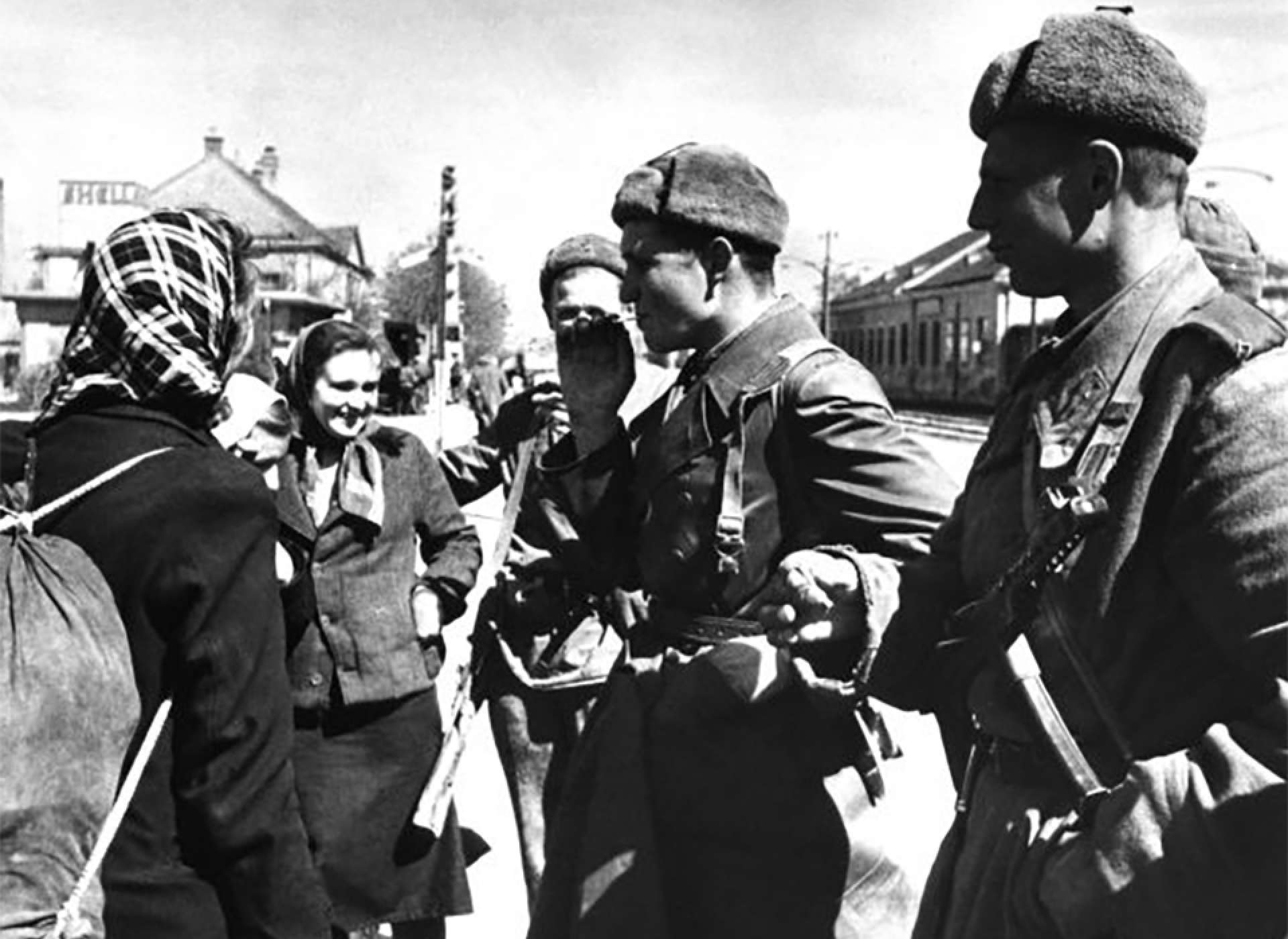
Soviet soldiers talking to liberated slave laborers from the Soviet Union in Vienna. Image courtesy of the Voennyi album and Tass.
The role of liberated slave laborers and prisoners of war in the mayhem of May 1945 must also be considered when examining the Soviet rampage. In Austria, there were hundreds of thousands of slave laborers out of 5 million Soviet citizens the Nazis had taken to the Third Reich from conquered territories. These people, liberated by the Red Army, frequently led the way in looting and in attacking civilians. The army also recruited heavily from the liberated prisoners of war and slave laborers, filling its ranks with tens of thousands of individuals who had a score to settle with the Germans. Such soldiers were also viewed suspiciously by the Stalinist regime for having been in captivity, and by acting aggressively against the enemy they demonstrated loyalty to the system. One such soldier, Aleksandr Levin, survived captivity for four years while concealing his Jewish identity from the Nazi captors. Freed from a camp in late April, he joined the 2nd Ukrainian Front. In the first letter to his family, on May 12, he wrote:
"(It is) terrible when I recall the hopelessness of existence in captivity, especially during the last two months which I spent in a stone torture chamber (zastenka). All, all, all of that is behind me! I am again a soldier of the Worker-Peasant Red Army. I now only regret that I wasn’t able to show in the battles for our Motherland that which I thought about the entire time that I was in captivity. Admittedly, I must say that I relieved part of my hatred on the heads of the ‘pure-blooded’ Aryan degenerates."
Considering that the fighting was almost over by the time Levin rejoined the Red Army, it is likely that he vented his hatred at civilians or prisoners of war.
Soldiers from the 3rd and 2nd Ukrainian Fronts fought through Romania, Bulgaria, Yugoslavia, and Hungary, before entering Austria. Although they committed many crimes everywhere, they looted and raped most intensely in Austria. According to one estimate, in Vienna alone, the Red Army raped between 70,000 and 100,000 women. There is a debate among historians whether Soviet conduct in Austria was as bad as in Germany, and the preponderance of evidence indicates that it was not, although it was similar.
For instance, one study indicated that 5.8 percent of all women between 15 and 60 years of age were raped in one Austrian district, whereas in Berlin the corresponding figure was 7.1 percent. As historians such as Maria Mesner and Jill Lewis have argued, the significance of these numbers is that they contradicted a more popular version, reflected in some academic texts, that virtually all women were raped.
Widespread looting accompanied the sexual assaults. Many soldiers reported that in the war’s closing stages they had ceased relying on field kitchens. They seized whatever food they wanted and cooked it on their own or forced the civilians to prepare it. In December 1944, Stalin allowed soldiers and officers to send parcels to the Soviet Union. The idea behind this policy was that it would alleviate the suffering of the population of the war-torn Soviet Union at the expense of enemy populations. The troops abroad received salaries in special military currency, which were completely useless. Thus, many soldiers simply plundered the goods their families and friends badly needed back home.
The wild looting and, particularly, sexual assaults were crimes from below that violated the standing policies. The command—at the level of army groups and Moscow—frequently issued orders reminding the troops that attacking civilians was impermissible, promising harsh penalties for perpetrators. The military and political leaders were not concerned with the fate of enemy civilians. However, the attacks, which were almost always accompanied by excessive consumption of alcohol and straggling from duty, detracted from the primary objective of defeating the enemy.
After the fighting ended, the assaults represented a political problem as they undermined Soviet rule in their occupation zone, and they delegitimized Moscow’s Austrian allies, the Communist Party of Austria. If anything could have stopped the rampage, it would have been the consistent implementation of the harshest penalty, the death sentence for the perpetrators. But officers responsible for the discipline themselves led the way in plundering, and in some cases, they also attacked women. Officers almost always sympathized with their long-suffering soldiers over civilians. Also, as historian Filip Slaveski pointed out with regard to the German context , given the number and intensity of attacks, officers would not have lasted long if they confronted every criminal in the ranks.
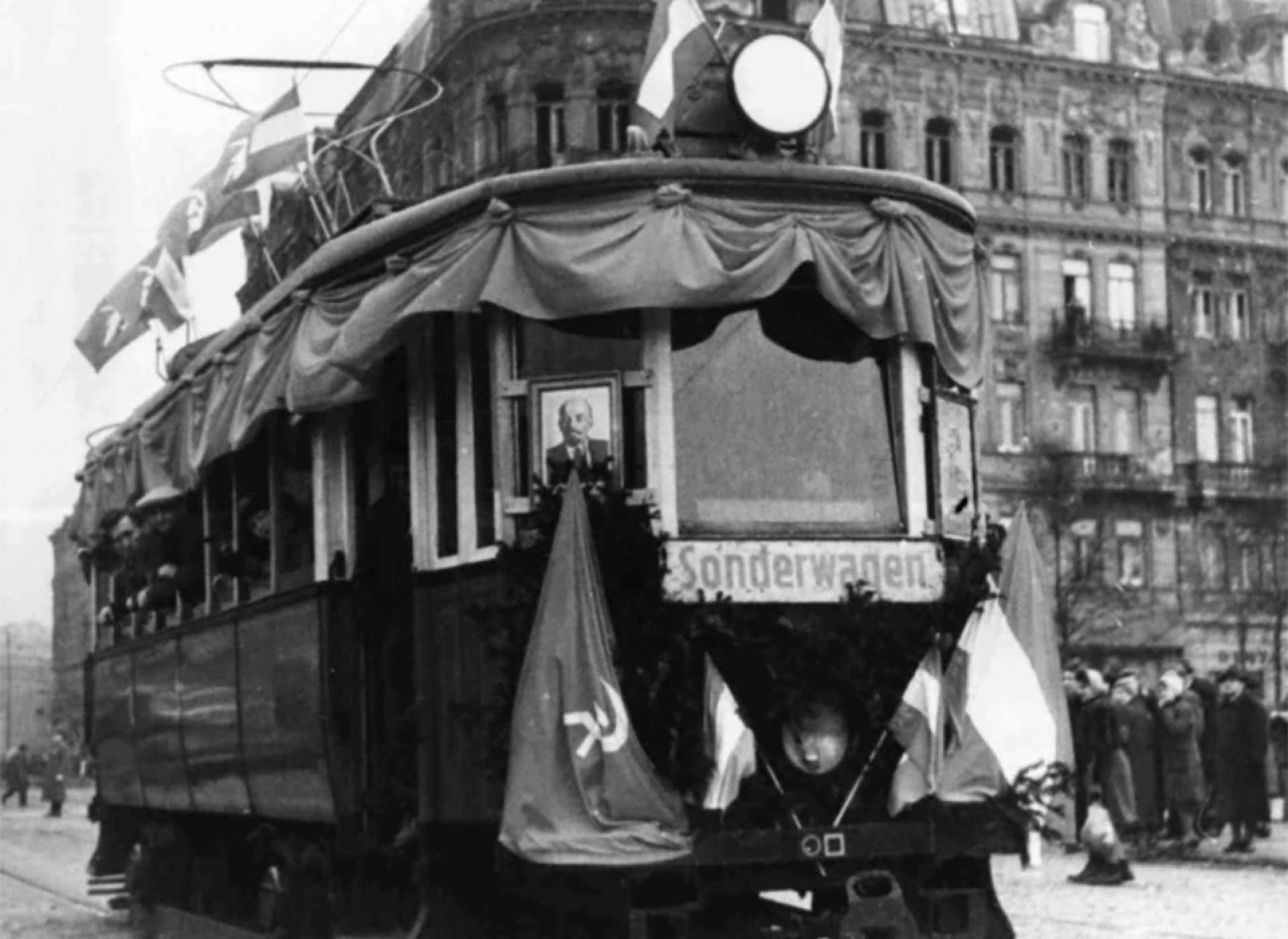
The Austrian flag flutters alongside the hammer-and-sickle and an image of Lenin on a tram crossing a newly repaired bridge in central Vienna in 1946. Image courtesy of Radio Free Europe.
Order was gradually restored in the Soviet zone in the summer and fall of 1945. The number of troops greatly diminished, from around 700,000 during the Vienna Strategic Offensive to 150,000 in 1946, and 50,000 when the occupation ended in 1955. Moreover, the frontline troops were placed under much stricter control in encampments and barracks after the war. Perhaps most significantly, occupation troops became comprised of more disciplined and better-trained troops, most of whom were from the NKVD. As the war turned into occupation and the representatives of the Soviet occupation apparatus began to interact more closely with Austrian civilians, the sexual relations between the Soviet men and Austrian women became less physically violent, and more transactional—and, in many instances, consensual.
According to the fascinating research of historian Barbara Stelzl-Marx, there were around 8,000 so-called soldier’s children born in Austria between 1946 and 1953, but the real number may have been around 30,000, since many women preferred to say that their child was illegitimate, rather than had a foreign father. According to Stelzl-Marx, the Nazi image of the enemy as one of “wild hordes from the East,” reinforced by the Red Army’s conduct and the humiliation of defeat led to discrimination against the so-called “Russian sweethearts,” as well as bullying, and even violence against children with Russian fathers.
Austrians tended to blame the Soviets for the difficult post-war situation. In reality, the war began taking a heavy toll on the population only in late 1944 and early 1945, as the American and British bombings became increasingly devastating. More than 20,000 Austrians were killed and 67,000 wounded in more than 1000 aerial attacks. The devastation continued as more than a million troops fought heavy battles across Austria. At this point, requisitions also added to the suffering of the civilian population. The most critical was the issue of food.
For instance, the daily calorie rations for the urban Austrian population fell from 2,000 calories in 1944 to between 350 and 850 calories in the spring and summer of 1945, before they were increased to 1,550 calories in September. Throughout 1946, the average Viennese was consuming 25 percent fewer fats and meat and 75 percent less bread than in 1937. The assistance from Allies, mostly from the USA but also the Soviet Union, fed the population.
The looting, raping, and hunger defined the end of the war for most Austrians. For them, the end of the war was not a liberation. The November 1945 parliamentary election, administered by the four occupying powers, resulted in the trouncing of the Communist Party of Austria, which won less than six percent of the national vote. The new government was formed by the coalition of Social Democrats and Christian Democrats, the traditional center-left and center-right Austrian parties. However, the Soviets continued to exercise control in their zone of occupation. The Soviets pulled out of the country in 1955, along with the Western Allies, in exchange for Austria’s promises that it would remain neutral in the Cold War. The Soviet Union released Austrian prisoners at a much faster rate than the Germans, but the last Austrians were not released until 1955.
In the discussion of the Soviet policies in Austria after the war, the alternative outcome of the war must not be kept out of the picture; had the Third Reich prevailed, there would be no Ukrainian, Russian, or Soviet state, all Jews would have been murdered, and the majority of Slavs murdered, expelled to Asia, or reduced to de facto slaves as Hitler’s regime built its thousand-year Reich. In this light, the Soviet government’s adherence to the Moscow Declaration of 1943, guaranteeing Austria’s independence, was correct, as the Kremlin’s failure to create a communist client state as it did in East Germany was restrained.
Admittedly, the Soviet government imposed burdensome reparations on the country that helped impoverish the population. What revolted Austrians the most, rightly so, was the issue of mass sexual violence and wild looting by the troops. The army leadership sought to prevent or at least minimize the rampage through propaganda, although it balked at subjecting a large number of its victorious troops to capital punishment. The troops understood their arrival on the Third Reich’s soil as their victory, and some soldiers were determined to exact a tribute from the defeated enemy by plundering, assaulting civilians, and committing rapes.
Austrians had their say in the end, though, when they trounced the Communist Party of Austria in the post-war parliamentary elections.
Meet the Author
Vojin Majstorovic got his PhD at the University of Toronto. He is an assistant professor of military history at the University of North Texas, where he teaches courses on World War II and the Holocaust. He studies the Red Army’s occupation of Southeastern and Central Europe, and how the Soviet armed forces reacted to encountering the Holocaust as they marched across the Western Soviet Union and Eastern Europe.
This article is part of a series commemorating the 75th anniversary of the end of World War II made possible by the Department of Defense.
Cite this article:
MLA Citation:
APA Citation:
Chicago Style Citation:
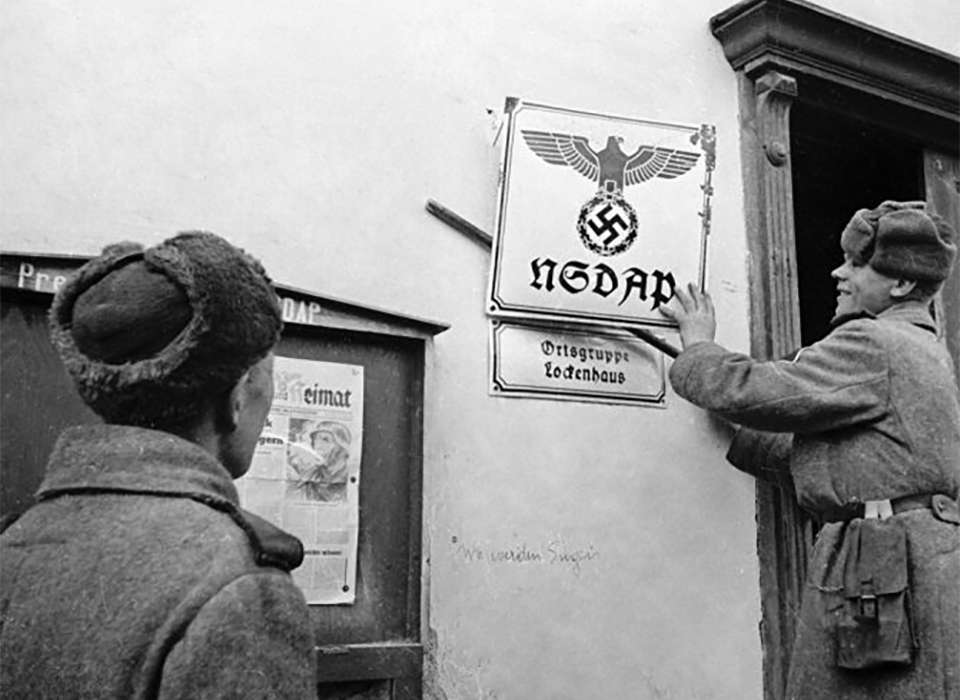

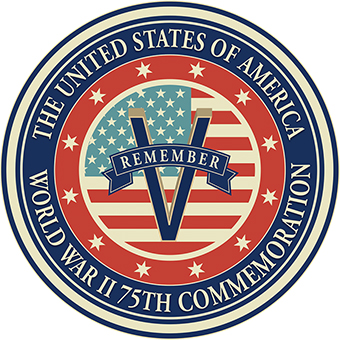

![Max Fuchs, New York City cantor, sings as Rabbi Sydney [sic] Lefkowitz, Richmond, VA, conducts the first Jewish services from Germany.](/sites/default/files/styles/max_650x650/public/2025-10/image1.jpg)




